Abstract
1 We have studied the effects of single oral doses of 80 mg propranolol and 100 mg metoprolol on the cardiovascular and respiratory responses to progressive exercise in nine healthy men in double-blind, placebo-controlled experiment. As judged by their effects on exercise heart rate and cardiac output the doses of the two drugs used were equivalent. 2 Beta-adrenoceptor blockade reduced oxygen consumption by 3.5% over the whole work range with an increase in the respiratory exchange ratio of 0.056 units. Carbon dioxide production and exercise ventilation were unchanged. The two drugs had similar effects. Possible mechanisms for these observations are discussed. 3 Perceived exertion during exercise was increased by both the beta-adrenoceptor blocking drugs and this may be of relevance to the symptom of fatigue reported by patients on these drugs. Endurance, assessed as either total work done or maximal work achieved, was reduced by 15%.
Full text
PDF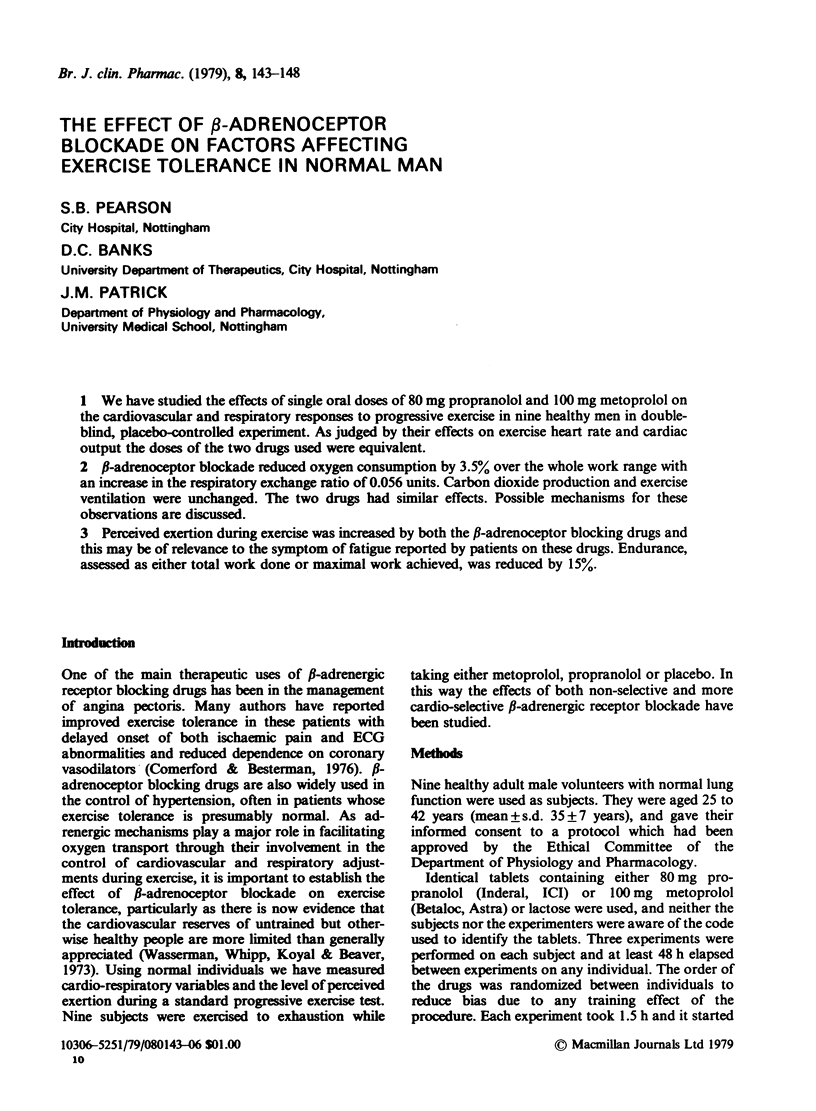
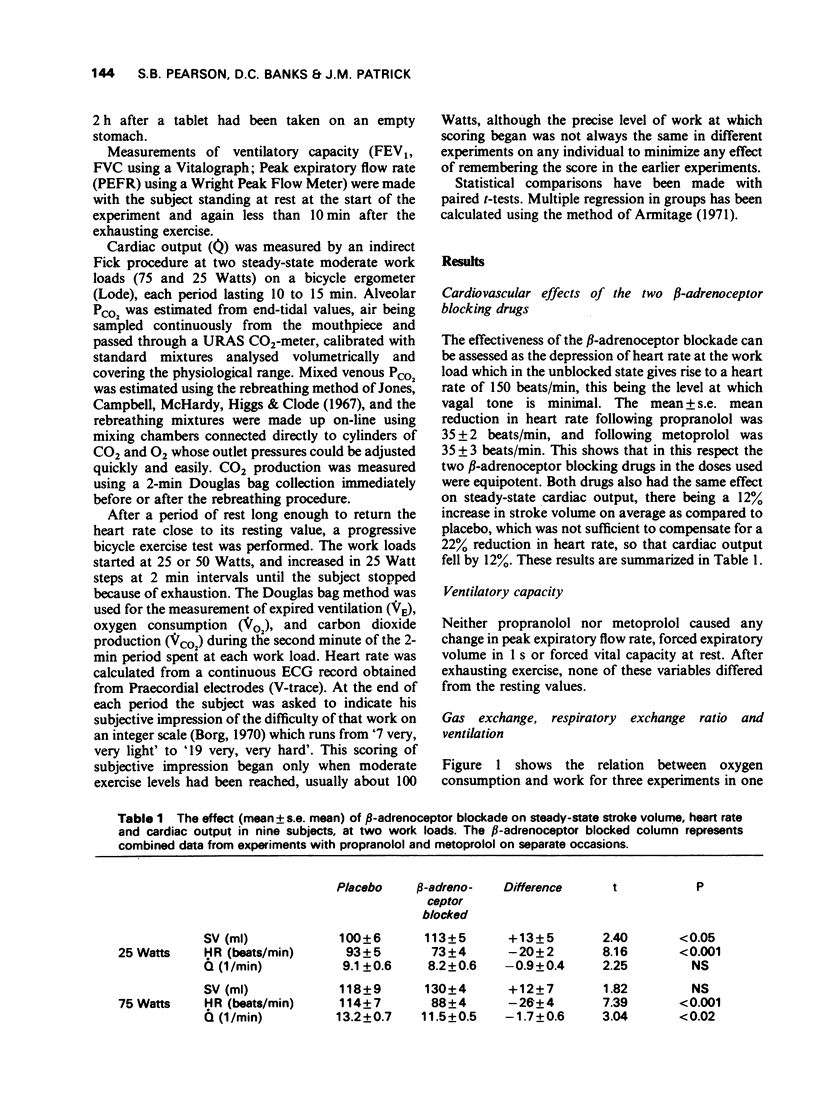
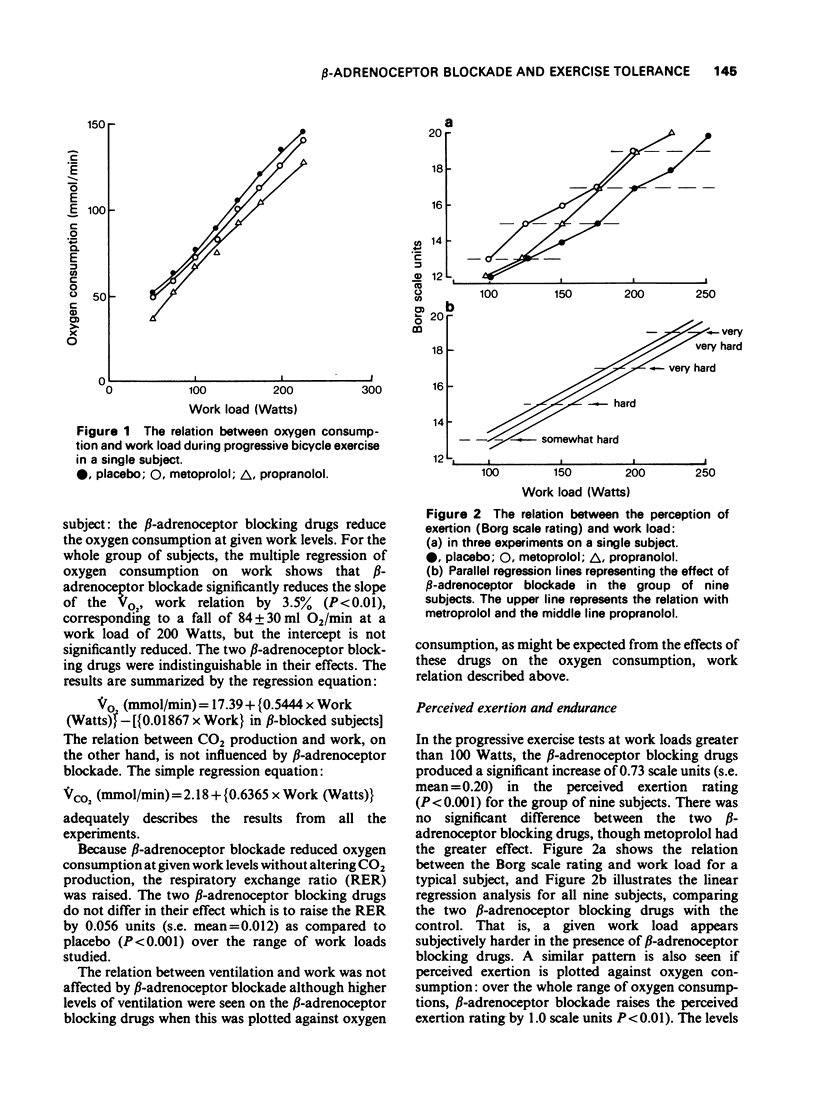
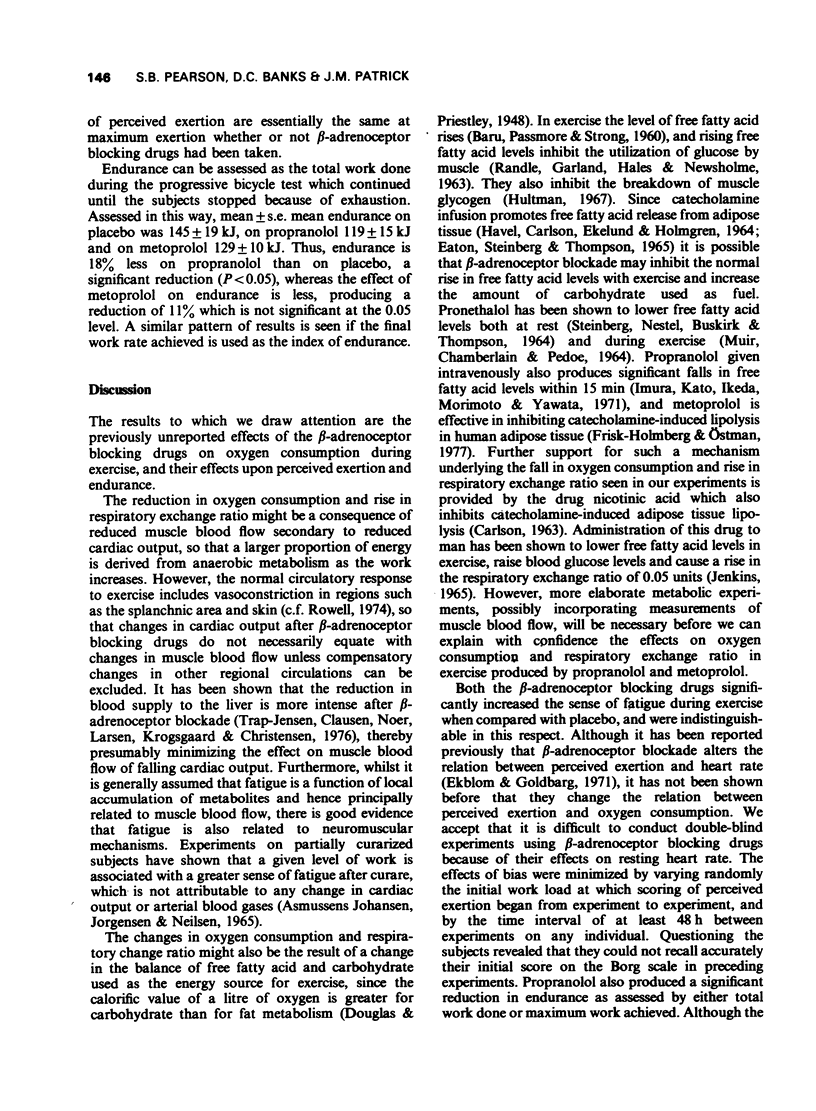
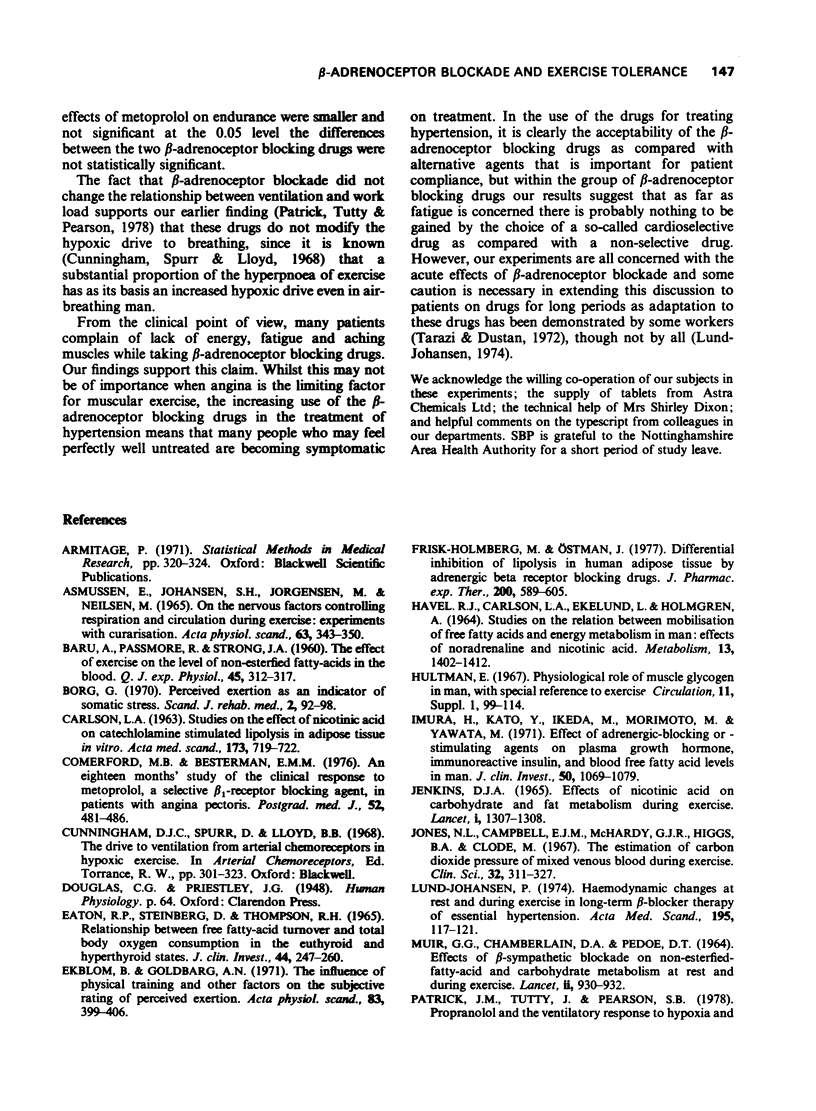
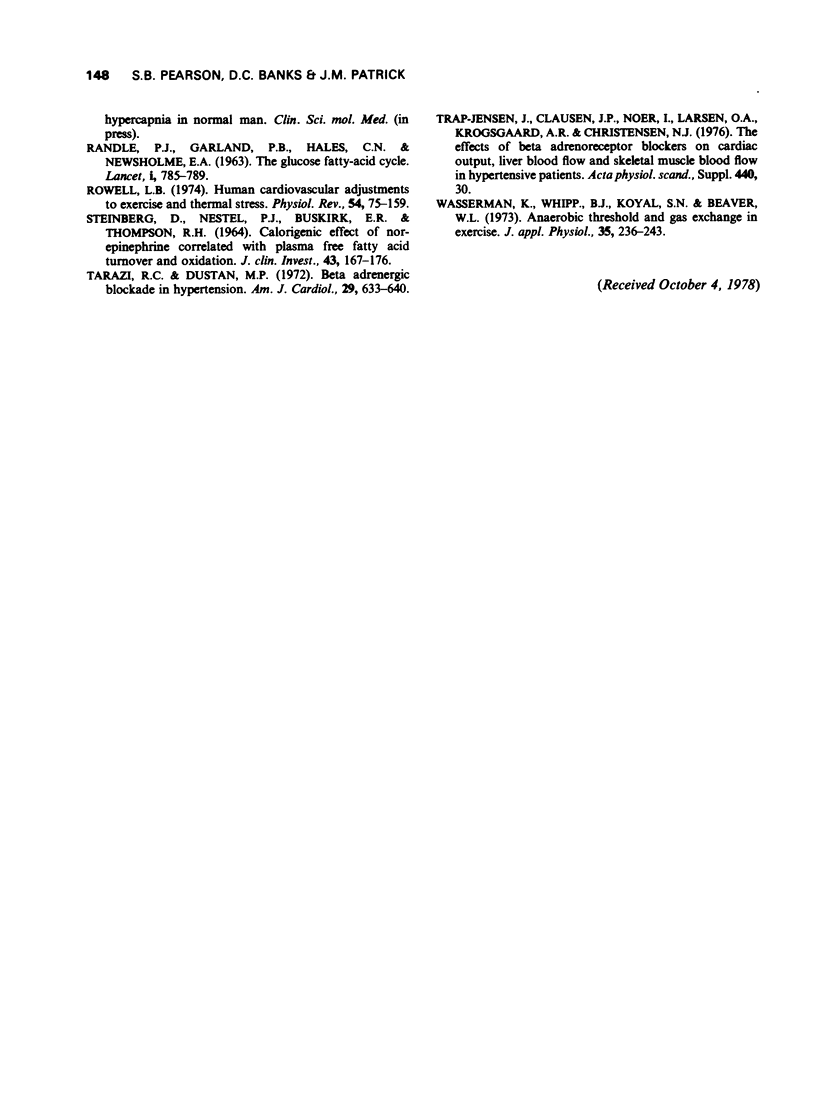
Selected References
These references are in PubMed. This may not be the complete list of references from this article.
- ASMUSSEN E., JOHANSEN S. H., JORGENSEN M., NIELSEN M. ON THE NERVOUS FACTORS CONTROLLING RESPIRATION AND CIRCULATION DURING EXERCISE. EXPERIMENTS WITH CURARIZATION. Acta Physiol Scand. 1965 Mar;63:343–350. doi: 10.1111/j.1748-1716.1965.tb04073.x. [DOI] [PubMed] [Google Scholar]
- BASU A., PASSMORE R., STRONG J. A. The effect of exercise on the level of non-esterified fatty acids in the blood. Q J Exp Physiol Cogn Med Sci. 1960 Jul;45:312–317. doi: 10.1113/expphysiol.1960.sp001476. [DOI] [PubMed] [Google Scholar]
- Borg G. Perceived exertion as an indicator of somatic stress. Scand J Rehabil Med. 1970;2(2):92–98. [PubMed] [Google Scholar]
- CARLSON L. A. Studies on the effect of nicotinic acid on catecholamine stimulated lipolysis in adipose tissue in vitro. Acta Med Scand. 1963 Jun;173:719–722. doi: 10.1111/j.0954-6820.1963.tb17457.x. [DOI] [PubMed] [Google Scholar]
- Comerford M. B., Besterman E. M. An eighteen months' study of the clinical response to metoprolol, a selective beta1-receptor blocking agent, in patients with angina pectoris. Postgrad Med J. 1976 Aug;52(610):481–486. doi: 10.1136/pgmj.52.610.481. [DOI] [PMC free article] [PubMed] [Google Scholar]
- EATON R. P., STEINBERG D., THOMPSON R. H. RELATIONSHIP BETWEEN FREE FATTY ACID TURNOVER AND TOTAL BODY OXYGEN CONSUMPTION IN THE EUTHYROID AND HYPERTHYROID STATES. J Clin Invest. 1965 Feb;44:247–260. doi: 10.1172/JCI105139. [DOI] [PMC free article] [PubMed] [Google Scholar]
- Ekblom B., Goldbarg A. N. The influence of physical training and other factors on the subjective rating of perceived exertion. Acta Physiol Scand. 1971 Nov;83(3):399–406. doi: 10.1111/j.1748-1716.1971.tb05093.x. [DOI] [PubMed] [Google Scholar]
- Frisk-Holmberg M., Ostman J. Differential inhibition of lipolysis in human adipose tissue by adrenergic beta receptor blocking drugs. J Pharmacol Exp Ther. 1977 Mar;200(3):598–605. [PubMed] [Google Scholar]
- HAVEL R. J., CARLSON L. A., EKELUND L. G., HOLMGREN A. STUDIES ON THE RELATION BETWEEN MOBILIZATION OF FREE FATTY ACIDS AND ENERGY METABOLISM IN MAN: EFFECTS OF NOREPINEPHRINE AND NICOTINIC ACID. Metabolism. 1964 Dec;13:1402–1412. doi: 10.1016/0026-0495(64)90034-4. [DOI] [PubMed] [Google Scholar]
- Imura H., Kato Y., Ikeda M., Morimoto M., Yawata M. Effect of adrenergic-blocking or -stimulating agents on plasma growth hormone, immunoreactive insulin, and blood free fatty acid levels in man. J Clin Invest. 1971 May;50(5):1069–1079. doi: 10.1172/JCI106578. [DOI] [PMC free article] [PubMed] [Google Scholar]
- Jones N. L., Campbell E. J., McHardy G. J., Higgs B. E., Clode M. The estimation of carbon dioxide pressure of mixed venous blood during exercise. Clin Sci. 1967 Apr;32(2):311–327. [PubMed] [Google Scholar]
- Lund-Johansen P. Hemodynamic changes at rest and during exercise in long-term beta-blocker therapy of essential hypertension. Acta Med Scand. 1974 Jan-Feb;195(1-2):117–121. doi: 10.1111/j.0954-6820.1974.tb08107.x. [DOI] [PubMed] [Google Scholar]
- MUIR G. G., CHAMBERLAIN D. A., PEDOE D. T. EFFECTS OF BETA-SYMPATHETIC BLOCKADE ON NON-ESTERIFIED-FATTY-ACID AND CARBOHYDRATE METABOLISM AT REST AND DURING EXERCISE. Lancet. 1964 Oct 31;2(7366):930–932. doi: 10.1016/s0140-6736(64)90862-1. [DOI] [PubMed] [Google Scholar]
- RANDLE P. J., GARLAND P. B., HALES C. N., NEWSHOLME E. A. The glucose fatty-acid cycle. Its role in insulin sensitivity and the metabolic disturbances of diabetes mellitus. Lancet. 1963 Apr 13;1(7285):785–789. doi: 10.1016/s0140-6736(63)91500-9. [DOI] [PubMed] [Google Scholar]
- Rowell L. B. Human cardiovascular adjustments to exercise and thermal stress. Physiol Rev. 1974 Jan;54(1):75–159. doi: 10.1152/physrev.1974.54.1.75. [DOI] [PubMed] [Google Scholar]
- STEINBERG D., NESTEL P. J., BUSKIRK E. R., THOMPSON R. H. CALORIGENIC EFFECT OF NOREPINEPHRINE CORRELATED WITH PLASMA FREE FATTY ACID TURNOVER AND OXIDATION. J Clin Invest. 1964 Feb;43:167–176. doi: 10.1172/JCI104901. [DOI] [PMC free article] [PubMed] [Google Scholar]
- Tarazi R. C., Dustan H. P. Beta adrenergic blockade in hypertension. Practical and theoretical implications of long-term hemodynamic variations. Am J Cardiol. 1972 May;29(5):633–640. doi: 10.1016/0002-9149(72)90164-6. [DOI] [PubMed] [Google Scholar]
- Wasserman K., Whipp B. J., Koyl S. N., Beaver W. L. Anaerobic threshold and respiratory gas exchange during exercise. J Appl Physiol. 1973 Aug;35(2):236–243. doi: 10.1152/jappl.1973.35.2.236. [DOI] [PubMed] [Google Scholar]


